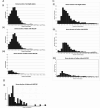UK neonatal stoma practice: a population study
- PMID: 38897635
- PMCID: PMC11671890
- DOI: 10.1136/archdischild-2024-327020
UK neonatal stoma practice: a population study
Abstract
Objective: The optimal time for neonatal stoma closure is unclear and there have been calls for a trial to compare early and late surgery. The feasibility of such a trial will depend on the population of eligible infants and acceptability to families and health professionals. In this study, we aimed to determine current UK practice and characteristics of those undergoing stoma surgery.
Design: A retrospective cohort study of neonates who had undergone stoma surgery (excluding anorectal malformations and Hirschsprung's disease) using three national databases: the National Neonatal Research Database (NNRD, 2012-2019), British Association of Paediatric Surgeons Congenital Anomalies Surveillance System (BAPS-CASS, 2013-2014) and Hospital Episode Statistics-Admitted Patient Care (HES-APC, 2011-2018).
Results: 1830 eligible neonates were identified from NNRD, 163 from BAPS-CASS, 2477 from HES-APC. Median (IQR) duration of stoma in days was 57 (36-80) in NNRD, 63 (41-130) in BAPS-CASS and 78 (55-122) for neonates identified from HES-APC. At the time of closure, there were low rates of invasive ventilation (13%), inotrope use (5%) and recent steroids use (4%). Infants who underwent earlier closure (<9 weeks) were less preterm (median 28 weeks vs 25 weeks), have higher birth weight (median 986 g vs 764 g) and more likely to have stoma complications (29% vs 5%).
Conclusion: There are sufficient UK neonates undergoing stoma formation for a trial. Stoma closure is performed at around 2 months, with clinical stability, gestation, weight and stoma complications appearing to influence timing. The variation in practice we document indicates there is opportunity to optimise practice through a trial.
Keywords: Gastroenterology; Intensive Care Units, Neonatal; Neonatology.
© Author(s) (or their employer(s)) 2025. Re-use permitted under CC BY. Published by BMJ Group.
Conflict of interest statement
Competing interests: None declared.
Figures

Similar articles
-
Timing of Stoma Closure in Neonates: the ToSCiN mixed-methods study.Health Technol Assess. 2024 Oct;28(71):1-130. doi: 10.3310/JFBC1893. Health Technol Assess. 2024. PMID: 39487601 Free PMC article.
-
Timing of neonatal stoma closure: a survey of health professional perspectives and current practice.Arch Dis Child Fetal Neonatal Ed. 2022 Jul;107(4):448-450. doi: 10.1136/archdischild-2021-322040. Epub 2021 Aug 19. Arch Dis Child Fetal Neonatal Ed. 2022. PMID: 34413091 Free PMC article.
-
Major stoma complications in pediatric patients in a tertiary hospital in a low-middle-income country: a retrospective cohort study.Pediatr Surg Int. 2024 Jul 23;40(1):208. doi: 10.1007/s00383-024-05791-0. Pediatr Surg Int. 2024. PMID: 39044020
-
[Gastrointestinal surgery and gastroenterology. XI. Stomas and stoma surgery].Ned Tijdschr Geneeskd. 2001 Jun 16;145(24):1144-8. Ned Tijdschr Geneeskd. 2001. PMID: 11433660 Review. Dutch.
-
Cue-based versus scheduled feeding for preterm infants transitioning from tube to oral feeding: the Cubs mixed-methods feasibility study.Health Technol Assess. 2021 Dec;25(74):1-146. doi: 10.3310/hta25740. Health Technol Assess. 2021. PMID: 34878383
Cited by
-
Risk factors for complications after infantile enterostomy: development of a clinical prediction model.Front Public Health. 2025 Jul 3;13:1566789. doi: 10.3389/fpubh.2025.1566789. eCollection 2025. Front Public Health. 2025. PMID: 40678655 Free PMC article.
-
STAT trial: stoma or intestinal anastomosis for necrotizing enterocolitis: a multicentre randomized controlled trial.Pediatr Surg Int. 2024 Oct 29;40(1):279. doi: 10.1007/s00383-024-05853-3. Pediatr Surg Int. 2024. PMID: 39470842 Free PMC article. Clinical Trial.
References
MeSH terms
LinkOut - more resources
Full Text Sources
